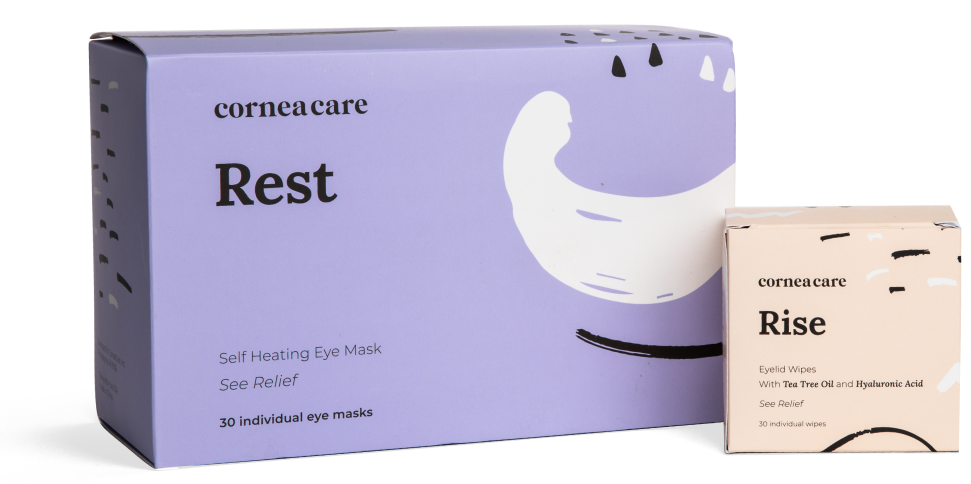Demodex blepharitis and dry eye disease are linked as Demodex mites are often the cause of dry eye disease. The symptoms of Demodex blepharitis are similar to an ocular surface disease, such as dry eye disease (DED), and so the root problem is sometimes missed.1 Symptoms of Demodex blepharitis and dry eye disease both include foreign body sensation, gritty feeling, burning, and itching.
While your dry eye symptoms may feel temporarily better after using artificial tears, if Demodex is the cause, artificial tears will definitely not be enough. Read on to learn more about Demodex blepharitis and dry eye disease, and effective treatment options.
Key Points
- Demodex are tiny mites that can be found in your hair follicles and sebaceous glands.
- Demodex blepharitis is caused by a Demodex infestation which disrupts the health of your eyelids, eyelashes, and the ocular surface.
- Dry eye disease is often linked with Demodex blepharitis, and can be treated with a good eyelid hygiene routine.
dry eyes seriously?
Understanding Demodex Blepharitis
Blepharitis (eyelid inflammation) is a common condition that affects over 180 million adults in the United States.2 The condition is often due to allergies or an overgrowth of bacteria that respond to antibiotics. However, when blepharitis fails to respond to treatment, Demodex must be considered as the cause.
Demodex are mites that live and die in your eyelash follicles and tear glands. Because they are so tiny, they can only be seen with microscopic imaging.
Demodex mites thrive on human skin and can be found in both your hair follicles and sebaceous glands. They are actually part of your skin’s natural microflora and do no harm in general. In fact, some studies suggest these ectoparasites help control bacteria levels.3
Problems arise though when Demodex begin to overpopulate. In that case, Demodex blepharitis and other ocular conditions may develop due to changes to the lid margin. These may include meibomian gland dysfunction, chalazia, styes, ocular rosacea, conjunctivitis, keratitis, and misdirected eyelashes.
There are two species of Demodex mites to be concerned about. Demodex folliculorum tend to gather at the base of the eyelashes. Demodex brevis are shorter mites that live in the sebaceous glands.
In fact, nearly half of all dry eye patients could have Demodex infestation, demodicosis, to blame for their symptoms.3
Risk Factors for Demodex Blepharitis
While a harmless number of Demodex can be found on most adults, age is a factor in Demodex infestation and its associated symptoms. Studies report that 100% of adults over the age of 70 are affected, and more than two-thirds of adults aged 60 and older.1,3
Further, there is a correlation between Demodex infestation and people who are immunocompromised, including people with HIV or cancer.4
Additionally, other risk factors for Demodex infestation include rosacea, being fair skinned, a diet of excess spicy foods and alcohol, stress, prolonged sunlight exposure, and smoking.4
Once demodicosis develops, you are at risk for Demodex blepharitis. Additionally meibomian gland dysfunction, conjunctivitis, keratitis, and eyelash disruptions may occur.
Studies have found that most patients needing cataract surgery also have Demodex blepharitis and dry eye disease. Further, it’s important to treat Demodex blepharitis, dry eye, and meibomian gland dysfunction before cataract surgery to reduce the risk of complications.5
Your eye doctor (optometrist or ophthalmologist) will look for the presence of collarettes, or cylindrical dandruff, at the base of the eyelashes, as these are an indicator of Demodex blepharitis. A high-magnification slit lamp may be used or a sample of your eyelashes may be placed under a microscope to confirm a Demodex blepharitis diagnosis.6
Research is so far inconclusive, but some studies show a higher incidence of Demodex mites in contact lens wearers.
Symptoms of Demodex Blepharitis
Demodex blepharitis is the result of an infestation of Demodex mites which disrupt the health of your eyelids, eyelashes, and the surface of your eyes.
If you have Demodex blepharitis, your symptoms may include:6
- Eye dryness
- Redness
- Tearing, watery eyes
- White flakes in your eyelashes
- Crusting of eyelashes
- Burning or stinging
- Irritation of eyes or eyelids
- Itchy eyes or eyelids
- Foreign body sensation
- Blurred vision fluctuation
- Sensitivity to light
- Loss of eyelashes
- Eye infections
You’ll notice many of these symptoms are shared by both Demodex blepharitis and dry eye disease. It’s critical that your eye doctor consider demodicosis, Demodex infestation, as the etiology of your dry eye disease because Demodex mites can cause serious, and sometimes permanent, damage to your eyelids, eyelashes, and meibomian glands. Early diagnosis and prompt treatment can make a difference.

Rise
Eyelid Wipes
Perfect for eye dryness, itching, burning, and crusting/flaking of eyelashes. Free shipping 📦
Try today - $25
Demodex Blepharitis and Dry Eye Disease
Research has shown that Demodex is often at the root of dry eye disease. When dry eye symptoms are present, your eye doctor should check the base of the eyelashes using a slit lamp to understand the prevalence of Demodex mites so that proper treatment can begin.3
In fact, when Demodex blepharitis and dry eye disease are related, you’ll most likely experience irritation of the lid margin in addition to the most common symptoms of dry eye disease.
What’s more, one sign that Demodex blepharitis may be an underlying issue, is a poor response to dry eye disease treatment.1
Examination of your tear film and tear glands can help determine whether Demodex mites or other factors are causing your dry eye syndrome.
Anterior blepharitis is indicated by the presence of flaky dandruff on the eyelashes and is related to the longer species of mite, Demodex folliculorum. The whitish deposits found on your eyelashes are made up of the epithelial cells and eggs these mites leave on your eyelashes. This results in eyelid irritation and inflammation.3
In the case of Demodex brevis, these shorter mites block your meibomian gland orifices.3 This blockage causes tear film instability, specifically reduced lipid (oil) secretion, which leads to meibomian gland dysfunction and dry eye disease.1 This presentation is known as posterior blepharitis.
Treatment Options for Demodex Blepharitis and Dry Eye Disease
Early detection of Demodex blepharitis and dry eye disease and promptly starting treatment are important for the health and comfort of your eyes.
Consistent eyelid hygiene can help eliminate Demodex mites. We recommend a daily routine of CorneaCare’s Rest Self-Heating Warm Compress and CorneaCare’s Rise Eyelid Wipes which are also beneficial in the treatment of dry eye disease.
Apply our warm compress to your eyes nightly to help keep the oil (meibum) in your eyelid glands soft. This will help prevent build-up and clogged ducts, lessening your risk of developing meibomian gland dysfunction.
Our eyelid wipes with tea tree oil can keep your eyelids clean by removing the buildup of Demodex mites and excess bacteria, reducing swelling and other symptoms.

Foundation
Eyelid Hygiene Plan 2
Perfect for eye dryness, burning, itching, crusting/flaking of eyelashes and inflamed eyelids. Free shipping 📦.
Try today - $45
While artificial tears may provide temporary relief of dry eye symptoms, artificial tears as well as treatments such as cyclosporine, antihistamines, doxycycline, and baby shampoo won’t work to kill off Demodex mites.1
In cases of moderate to severe blepharitis, your eye doctor may also recommend an antibiotic or an anti-parasitic medication.
There are also a number of in-office procedures your eye doctor may try to treat chronic blepharitis in addition to lid hygiene. These may include:1
- Lid margin cleaning
- Thermal pulsation
- Intense pulsed light (IPL) therapy
- Microblepharoexfoliation with BlephEx
Tea Tree Oil for Demodex Blepharitis
Through clinical trials, researchers have found tea tree oil may be beneficial in the treatment of Demodex blepharitis.7
The most potent ingredient in tea tree oil, Terpinen-4-ol, causes the Demodex mite to move away from the lash follicle and onto the skin. Consistent treatment over 4 weeks has proven effective at reducing demodicosis, Demodex infestation. Tea tree oil’s anti-inflammatory properties are further beneficial to reducing Demodex blepharitis symptoms.3
Tea tree oil can cause allergic reactions and skin irritation, so it may be best to stick with low-concentration treatments.3
Your eye doctor may recommend Cliradex (Bio-Tissue) which is available as an over-the-counter lid margin cleanser containing tea tree oil. We recommend CorneaCare’s Rise Eyelid Wipes which contain both tea tree oil and hyaluronic acid to remove build-up and reduce Demodex mites. Moreover, the tea tree oil in our wipes is low concentration to minimize side effects.
Putting It All Together
Demodex mites are often the cause of dry eye disease, linking Demodex blepharitis and dry eye disease. Due to the symptoms of Demodex blepharitis and dry eye disease being similar, the root cause is too often overlooked.
Early detection and the prompt start of treatment is important to get you relief and preserve the health of your eyes. In addition to the treatment options described above, dietary changes including supplementation with eye vitamins and omega-3 fatty acids can keep your eyes healthy for life.8
What’s Next
Learn more about Dry Eye Disease including the causes and treatment options.




